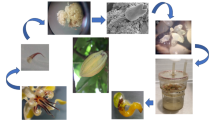Abstract
The previously-found correlation of P-grain frequency in situ (pollen grains which are able to form embryos in culture) with floral induction and sex balance of tobacco plants (Nicotiana tabacum L. var. Badischer Burley) was studied in more detail in order to find out in which stage of sexual development P-grain induction takes place. To know the time of P-grain induction is important for attempts to intervene more specifically in plant development, particularly with chemicals, with the aim of inducing P-grain formation. It was found that the floral stimulus was not involved in the control of both sex balance and P-grain formation. Rather, sex balance and P-grain formation were controlled by factors operating during flower development, that is, after floral induction period. Furthermore, both phenomena seemed to be controlled by the same factors, since changes in P-grain frequency and sex balance followed the same time course when flowering plants were transferred from short-day conditions at 24° C to 18° C and vice versa. These transfer experiments also revealed that the process of P-grain induction starts early in flower development, that is, well before meiosis (about five weeks before anthesis), but that the potential P-grains can return to normal gametophytic development until after meiosis. Pollen embryogenesis is regarded as a form of induced apogamy and is discussed in relation to an alternation of generations.
Similar content being viewed by others
Abbreviations
- LD24:
-
long days at 24° C
- PD:
-
pollen dimorphism
- P:S:
-
ratio of pistil to stamen length
- SD18:
-
short days at 18° C
References
Bell, P.R. (1970) The archegoniate revolution. Sci. Prog. Oxf. 58, 27–45
Bell, P.R. (1979) The contribution of the ferns to an understanding of the life cycle of vascular plants. In: The experimental biology of ferns, pp. 58–85, Dyer, A.F., ed. Academic Press, New York London San Francisco
Bennett, M.D., Hughes, W.G. (1972) Additional mitosis in wheat pollen induced by ethrel. Nature (London) 240, 566–568
Correns, C. (1928) Bestimmung, Vererbung und Verteilung des Geschlechtes bei den höheren Pflanzen. In: Handbuch der Vererbungswissenschaft, vol. 2, Baur, E., Hartmann, M., eds. Gebr. Bornträger, Berlin
Dickinson, H.G., Heslop-Harrison, J. (1970) The ribosome cycle, nucleoli and cytoplasmic nucleoloids in the meiocytes of Lilium. Protoplasma 69, 187–200
Dickinson, H.G., Heslop-Harrison, J. (1977) Ribosomes, membranes and organelles during meiosis in angiosperms. Phil. Trans. R. Soc. London, Ser. B 277, 327–342
Heberle-Bors, E. (1982) In vitro pollen embryogenesis in Nicotiana tabacum L. and its relation to pollen sterility, sex balance, and floral induction of the pollen donor plants. Planta 156, 396–401
Heberle-Bors, E., Reinert, J. (1979) Androgenesis in isolated pollen cultures of Nicotiana tabacum: dependence upon pollen development. Protoplasma 99, 237–245
Heberle-Bors, E., Reinert, J. (1981) Environmental control and evidence of predetermination of pollen embryogenesis in Nicotiana tabacum pollen. Protoplasma 109, 249–255
Heslop-Harrison, J. (1957) The experimental modification of sex expression in flowering plants. Biol. Rev. 32, 38–90
Heslop-Harrison, J. (1971) The cytoplasm and its organelles during meiosis. In: Pollen: development and physiology, pp. 16–31, Heslop-Harrison, J., ed. Butterworth, London
Heslop-Harrison, J. (1980) The forgotten generation: some thoughts on the genetics and physiology of angiosperm gametophytes. In: The plant genome, pp. 1–14, Davies, D.R., Hopwood, D.A., eds. The John Innes Charity, Norwich
Horner, M., Mott, R.L. (1979) The frequency of embryogenic pollen grains is not increased by in vitro anther culture in Nicotiana tabacum L. Planta 147, 156–158
Hu Chung, Huang, Shi-chou, Ho Ching-po, Liang, Han-chih, Chuang Cheng-chi, Peng Li-ping (1978) On the inductive conditions of rice pollen plantlets in anther culture. In: Proceedings of symposium on plant tissue culture, pp. 87–95. Science Press, Peking
Kasperbauer, M.J. (1969) Photo- and thermo-control of pretransplant floral induction in Burley tobacco. Agron. J. 61, 898–902
Kasperbauer, M.J. (1970) Photo- and thermo-control of flowering in tobacco (Nicotiana tabacum L.). Agron. J. 62, 825–827
Lang, W.H. (1909) A theory of alternation of generations in archegoniate plants based upon the ontogeny. New Phytol. 8, 1–12
Pandey, K.K. (1973) Theory and practice of induced androgenesis. New Phytol. 72, 1129–1140
Whittier, P.D., Steeves, T.A. (1960) The induction of apogamy in the bracken fern. Can. J. Bot. 38, 925–930
Author information
Authors and Affiliations
Rights and permissions
About this article
Cite this article
Heberle-Bors, E. On the time of embryogenic pollen grain induction during sexual development of Nicotiana tabacum L. plants. Planta 156, 402–406 (1982). https://doi.org/10.1007/BF00393310
Received:
Accepted:
Issue Date:
DOI: https://doi.org/10.1007/BF00393310




